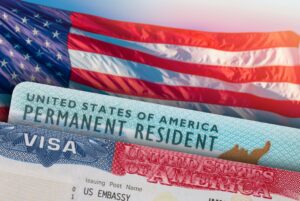For couples who want to marry and live in the United States, you may be considering a fiancé visa vs marriage green card. It can be challenging to come to a decision since both options are similar, but they do have some significant differences that you should first consider. Before making a decision, you need to fully understand the requirements, application process, costs, and timelines for each option. Here is everything you need to know about a fiancé visa vs marriage green card and which choice is better for your situation.
Fiance Visa Vs. Marriage Green Card
Fiancé and marriage visas can be quite confusing since they may seem as though they are the same thing on the surface. The United States immigration system can be very overwhelming overall, which is why you must research each option thoroughly before deciding on a fiancée visa vs a marriage green card. It is also highly recommended that you hire an immigration attorney to help you when you are making this decision.
An experienced immigration attorney will be able to help you differentiate between a fiancé visa vs a spouse visa, so you can choose the best option. They can also help you throughout the application process, ensuring you meet the eligibility criteria and provide all of the information that is required.
Fiance Visa
A K-1 fiancé visa is an option for couples who are engaged but not yet married. Couples who want a K-1 visa have plans to marry in the U.S. and will need a temporary visa so that the fiancé, who is an immigrant, can enter the U.S. for the purpose of getting married. After receiving a temporary K-1 visa, they will then need to apply for a green card to become a permanent U.S. resident.
The eligibility criteria for a K-1 visa is that the foreign partner has to live outside of the United States and is legally free to marry. They must have met their U.S. citizen fiancé in person within the last two years and not have any serious crime convictions.
As far as immigration options go, the processing time for a K-1 visa is quite minimal, as it usually takes between three and six months. When applying, you need to provide a passport, birth certificate, police certificates from countries where you have lived for more than six months, evidence of your relationship to a U.S. citizen, and a divorce decree or death certificate if you were previously married.
You also need to be prepared to pay the K-1 visa filing fee, which is $800. If you are converting a fiancée visa to a spouse visa, you will also need to file an adjustment of status form, which will bump this fee up to $2380.
Marriage Green Card
If you are trying to decide which is better between a fiancé visa or marriage visa, this can get quite confusing. Part of the confusion is that visas are often called several different names, even though they all mean the same thing. For instance, a marriage green card can also be called a spouse visa or CR-1 visa, despite meaning the same thing.
The marriage green card requirements are a bit more extensive than a fiancé visa as you must have a sponsor who is a U.S. citizen or legal permanent resident. The couple must also already be lawfully married and have a valid marriage certificate as well as proof of authenticity, such as photographs and communication. The sponsor must also pledge support and file an affidavit of financial support.
The wait time for a marriage green card is also a bit longer as it averages around nine months. This can be influenced by how many people are applying for a CR-1 visa at the time and whether you are married to a U.S. citizen or a green card holder.
To apply for a marriage green card, you need to file form I-130, form G-1145, a cover letter, proof of marriage, and passport photos, as well as pay the $535 filing fee.
Which is Better: K-1 or CR-1 Visa
Now that you know more about fiancé visas vs marriage green cards, you must decide which one is better for your situation. Whether you choose a marriage visa vs a fiancé visa will depend on your situation and what your priorities are.
It is also worth mentioning that there used to be the option of a K-3 visa but has since gone out of fashion. This used to be an option that allowed the foreign spouse of a U.S. citizen to enter the U.S. while their petition for alien relatives was pending. Now, however, CR-1 visas are the preferred choice since they skip many of the steps a K-3 visa requires and provide a more straightforward process.
Here are some of the benefits and downsides of K-1 visas and CR-1 visas.
K-1
The main benefits of a K-1 visa is that the processing time is much faster and allows you to have your dream wedding in the U.S. It also provides couples with the option of testing their compatibility together in the United States before going through with the actual marriage.
However, the downside to a K-1 visa is that it is only temporary and you will have to get a green card later on, which will increase the overall cost.
CR-1
The most significant benefit of a CR-1 spousal visa is that the immigrant spouse will become a permanent resident immediately once they enter the United States. This will also grant them immediate work authorization and the ability to travel. There also isn’t a 90-day deadline for the wedding when you have a CR-1 visa like you have when you get a K-1 visa.
The main downside to this option is that it does take longer to acquire and you have to provide more documentation, especially when it comes to proving the legitimacy of the relationship.
Hire an Immigration Attorney Today
Are you considering the difference between a K-1 and a CR-1 visa? Contact us today at U.S. Immigration Law Counsel at 800-666-4996 to speak with an immigration attorney about your case. We will deal with the government, so you don’t have to!




